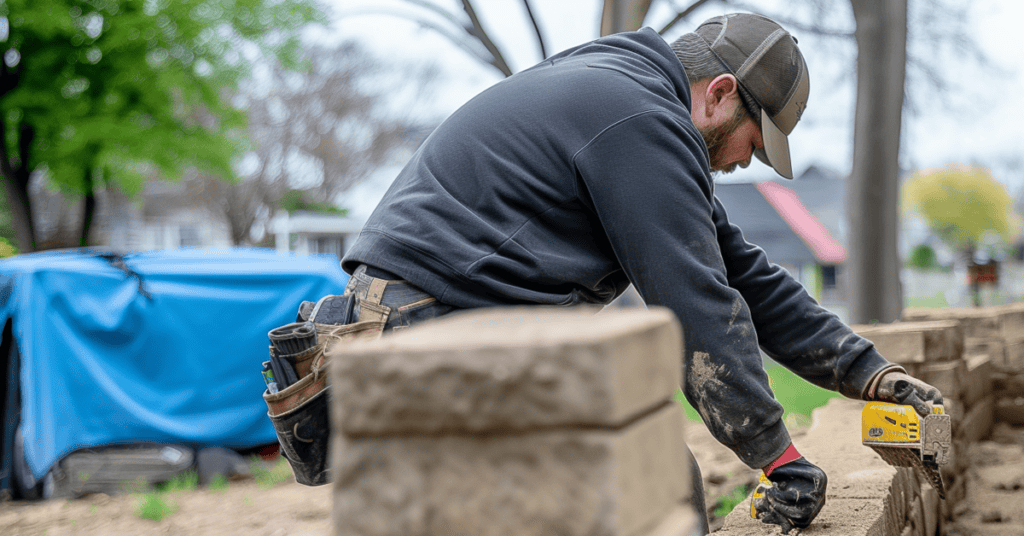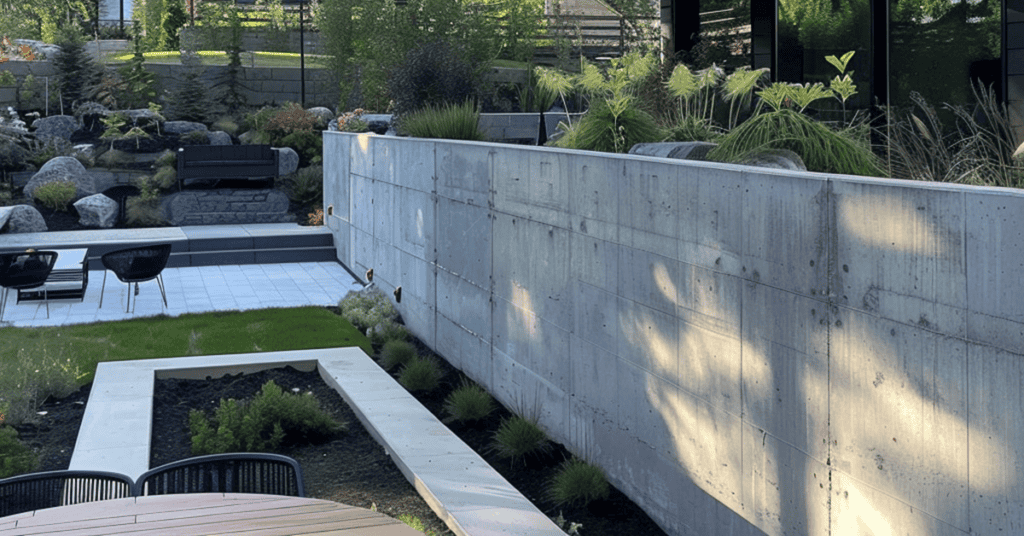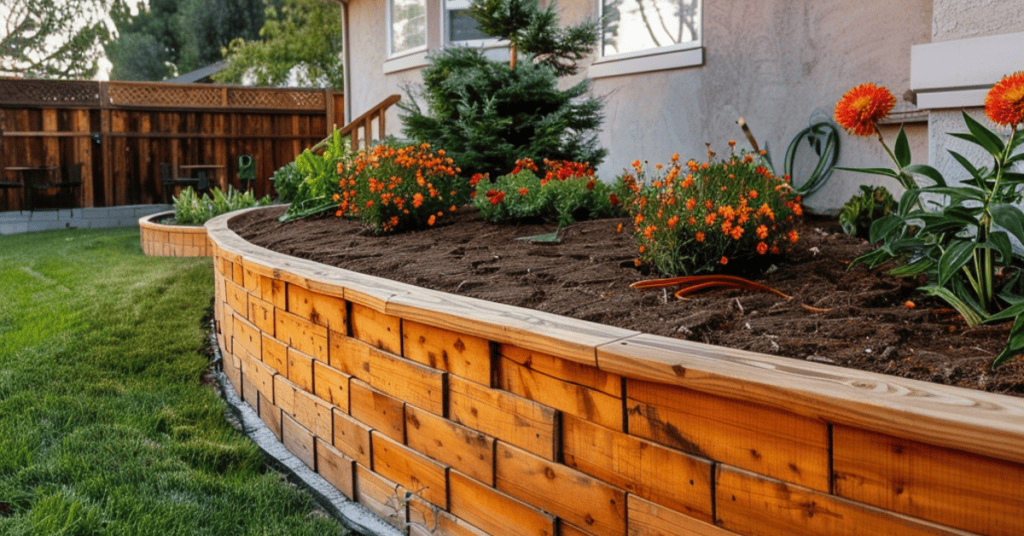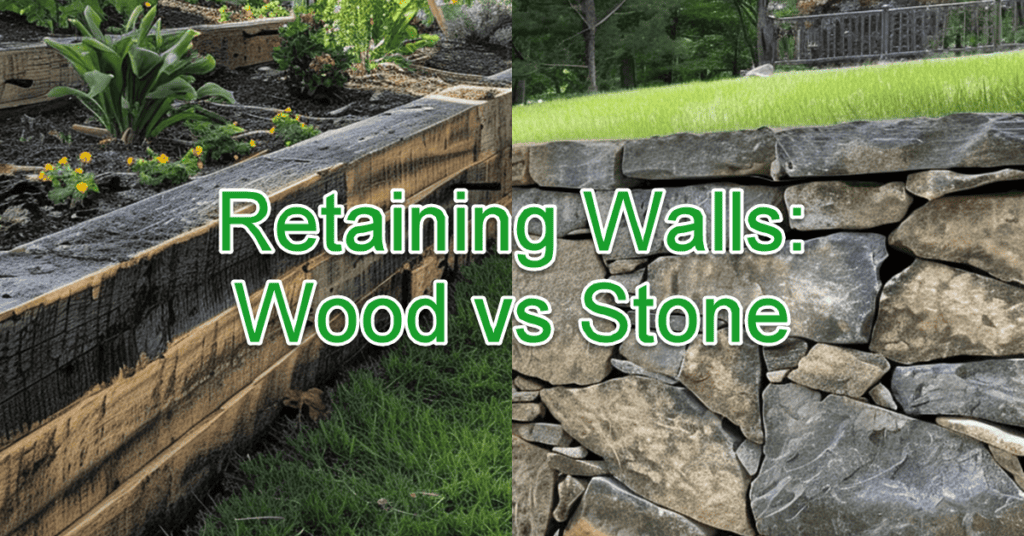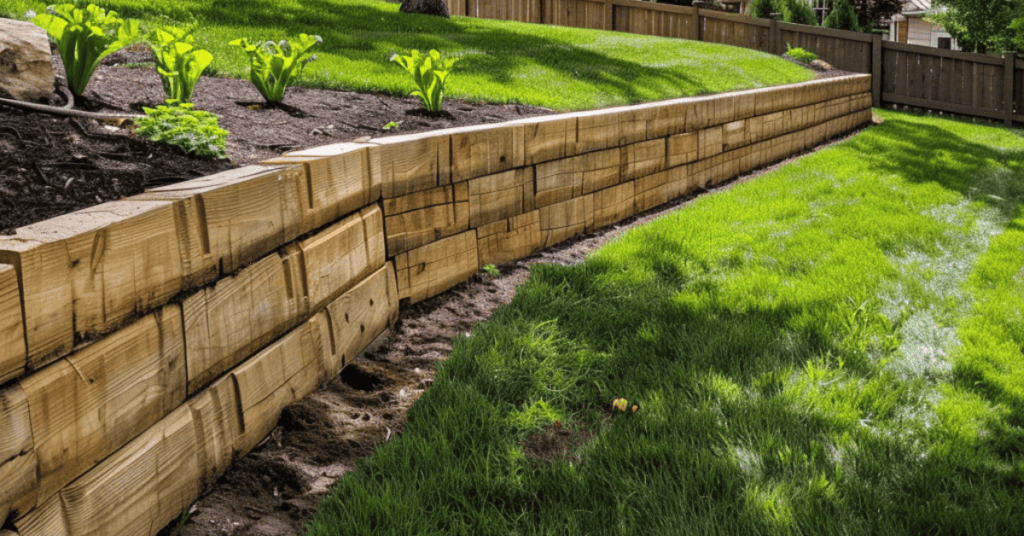Understanding Retaining Walls in Gardens
Retaining walls offer essential support to your garden, helping manage soil erosion and enhancing your landscaping. They not only do an excellent job as garden walls, they also create level areas in sloped regions and add visual appeal to your outdoor space.
Purpose and Functionality
Retaining walls serve several key functions in a garden. They support soil on slopes, preventing erosion and landslides. This allows you to create level areas for planting, seating, or paths.
Retaining walls help with water drainage as well. Proper drainage prevents water buildup behind the wall, which could cause damage. Some walls feature built-in drainage systems, including perforated drainpipes or layers of crushed rock.
Retaining walls can also define garden spaces, creating distinct zones. This can improve your garden’s layout and make maintenance easier. They provide aesthetic value by adding texture and height to your landscape, transforming a plain slope into a focal point.
Types of Retaining Walls
Several types of retaining walls suit different garden needs. Gravity walls rely on their weight to hold back soil. These are ideal for smaller slopes and use materials like stone or concrete.
Cantilever walls use a lever arm structure and support more weight than gravity walls. These walls often include steel bars and concrete, making them suitable for larger areas.
Sheet pile walls consist of thin steel, vinyl, or wood sheets driven deep into the ground. They fit narrow spaces and support taller slopes.
Anchored walls use cables or rods anchored into the soil, providing extra support. These walls combine with other types to reinforce large or unstable slopes. This design maximizes stability and safety.
Choosing the right retaining wall for your garden depends on the slope, soil type, and desired aesthetic. Each type offers unique benefits, and selecting the right one ensures both a functional and beautiful garden.
Design Considerations for Retaining Walls
Careful planning is crucial when creating a retaining wall for your garden. Focus on meeting your landscape needs, picking suitable materials, and blending the wall with your garden’s design.
Evaluating Landscape Requirements
First, assess your garden’s topography. Look for slopes, soil types, and water runoff patterns. This will help you decide the height and length of your retaining wall. Pay attention to drainage, as poor drainage can weaken the wall.
Consider the soil structure. Clay soils might require deeper foundations. Sandy soils need extra support. Check if you need a permit for walls taller than three feet. Hire an engineer for walls over five feet tall.
Evaluate the area for stability. Steeper slopes need stronger supports. Ensure that the wall aligns with your garden’s layout and complements your outdoor space.
Choosing the Right Materials
When you’re coming up with retaining wall ideas, materials play a huge role in both form and function. Different materials suit different designs. Stone gives a rustic feel and lasting structure. Wood looks natural but may rot over time. Concrete offers strength and versatility. Think about the climate as well. Stone withstands changes in temperature. Wood handles dry climates well.
Select materials based on your property style. Match materials to existing garden features. Concrete blocks can interlock for greater stability. Dry-laid stone needs careful placement for a secure foundation.
Ensure the base extends a foot beyond the wall’s front and back. Place the largest stones at the wall’s base for stability. Choose materials that enhance your garden while meeting structural needs.
Integrating with Garden Design
Make the retaining wall a garden feature. It should blend with your landscape design. Use the wall to create levels and add interest to flat areas. Incorporate seating areas or planters into the wall.
Consider the wall’s color and texture. Stone and wood offer natural tones that can match plants and existing structures. Concrete can be painted or textured to fit your garden style.
Plan for the wall to complement nearby plants. It should provide structure without overshadowing your garden’s beauty. Use the wall to guide walkways or outline garden paths. Enhance your outdoor space with a retaining wall that integrates seamlessly into your property.
Selection of Materials for Durability and Aesthetics
Choosing the right material for your garden retaining wall involves balancing durability and visual appeal. Some materials stand out for their strength, while others offer unique looks that can enhance your garden.
Stone Varieties
Natural stone retaining walls provide both strength and natural beauty. It’s a popular choice for its long-lasting properties and low maintenance needs. You can choose from various stone wall types like granite, limestone, and fieldstone. Each type of stone retaining wall has a unique color and texture, allowing you to match your garden’s style.
Natural stone walls blend well with most garden designs. A rock wall can resist weathering and age gracefully. However, stone can be heavier and harder to install compared to other options. As a result, the upfront cost may be higher, but its longevity often offsets these concerns.
Wood and Timber Options
Wood and timber offer a rustic charm for retaining walls. Wood retaining walls with treated lumber are an ideal choice as treated wood helps to resist rot and insect damage. Popular choices include cedar, redwood, and pressure-treated pine. These materials create a warm and inviting look.
Wood walls require more maintenance. You’ll need to periodically stain or seal your timber retaining wall to prolong its life. This natural material may not last as long as stone or concrete, especially in wet climates. Think about the environmental impact as well, as wood can be more sustainable when sourced responsibly.
Concrete and Its Forms

A Concrete Paver Retaining Wall with a Flat Concrete Wall Cap on Top of the Wall
Concrete stands out for its versatility and strength. You can choose from poured concrete or precast concrete retaining wall blocks. A precast retaining wall block offers uniformity and ease of installation. Many wall blocks are interlocking which makes assembly of a retaining wall a bit easier, and doesn’t require the use of an adhesive or mortar. Concrete block walls are among the most common types of retaining walls – and you can easily install a planting area with a garden bed on top of the space created by a retaining wall.
Poured concrete allows for custom shapes and designs.
Both types handle soil pressure well, making them a durable option. Concrete walls require minimal upkeep, which adds to their appeal. You can even stain or paint concrete to match your garden theme. This material might not offer the same natural look as stone but excels in durability.
Brick Retaining Walls
Brick retaining walls for flower beds offer significant advantages in terms of aesthetics and durability. They provide a classic, timeless look that enhances the visual appeal of a garden, with various colors and finishes available for customization.
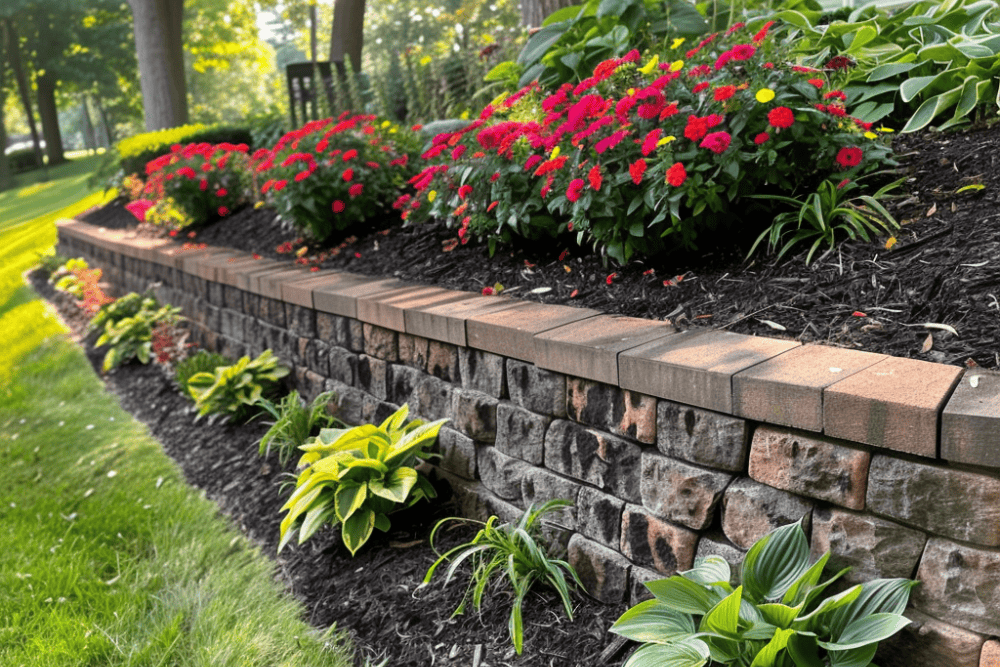
A Brick Retaining Wall with Flowers on Top
Bricks are also highly durable, capable of withstanding the elements for many years with minimal maintenance. Their strength ensures effective support for retaining soil, also making them ideal for larger flower beds. Additionally, bricks are environmentally friendly, being recyclable and providing good thermal mass to protect plant roots from extreme temperatures.
However, there are some drawbacks to using brick retaining walls. The cost can be prohibitive, as both the materials and the skilled labor required for proper installation can be expensive. The installation process is labor-intensive and time-consuming, often requiring a solid foundation to prevent shifting and settling.
Moreover, once built, brick walls offer little flexibility for modification or relocation. Proper drainage planning is essential to prevent water buildup behind the wall, which can cause pressure and potential damage over time. Despite these challenges, the longevity and aesthetic benefits of brick retaining walls often justify the investment for many gardeners.
Construction Techniques for Stability
DIY Retaining Wall for a Small Garden Bed
When building a retaining wall for your garden, several construction techniques can ensure long-term stability. These focus on the foundation, drainage, and reinforcing the wall.
Foundation and Base Considerations
A solid foundation is critical for stability. Start by digging a trench about six inches deep to firmly place the first layer of blocks. Make the trench wide enough to accommodate the blocks.
Use crushed stone as the base. Spread it evenly and compact it using a hand tamper. This base layer provides a level and stable surface for your wall.
Concrete blocks or interlocking blocks are good choices for a sturdy foundation. For dry stack walls, no mortar is needed. Ensure each block is level before moving to the next layer. 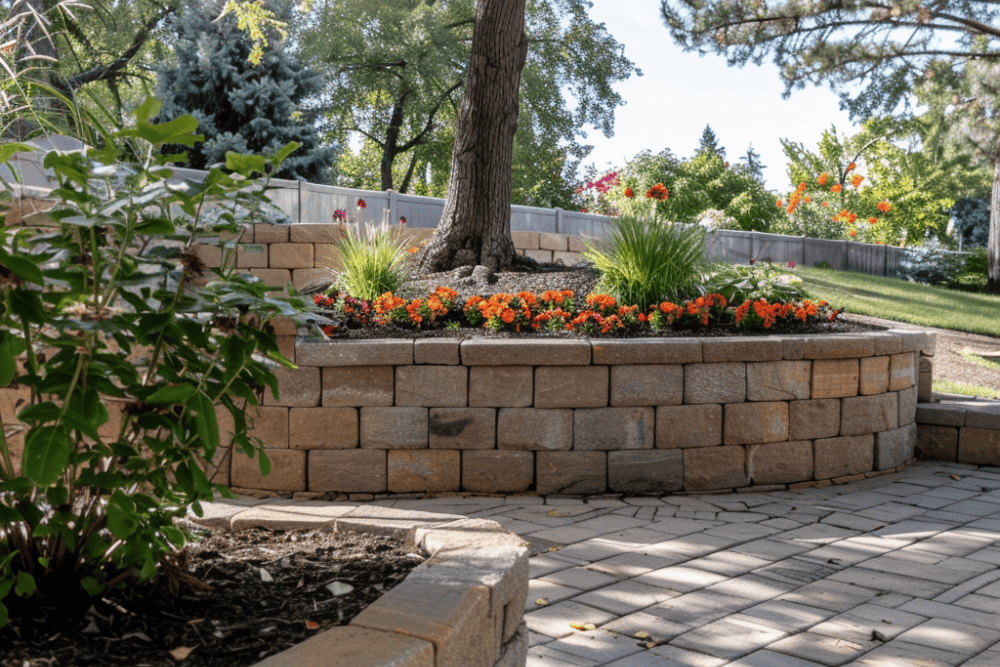
Multi-Level Terraced Gardens on Top of Retaining Walls
Drainage Solutions
Proper drainage prevents water pressure behind the wall. This can cause failure. Include a drainage system to handle water flow.
You can use perforated pipes at the base of the wall to direct water away. A layer of gravel behind the wall helps with drainage. This layer should be at least six inches thick.
Geotextile fabric between the soil and gravel stops the soil from mixing with the gravel. This keeps the drainage system effective.
Building Reinforced Walls
For added strength, you can reinforce the wall. Use methods like backfilling and using reinforcements.
Backfill the area behind the wall with gravel or crushed stone. This locks the blocks in place and provides additional drainage.
Reinforcing with steel bars or geogrid materials adds strength. Place these reinforcements at intervals as the wall height increases. For higher walls, consider using mortared stone for additional stability. Seeking guidance from experts can also help.
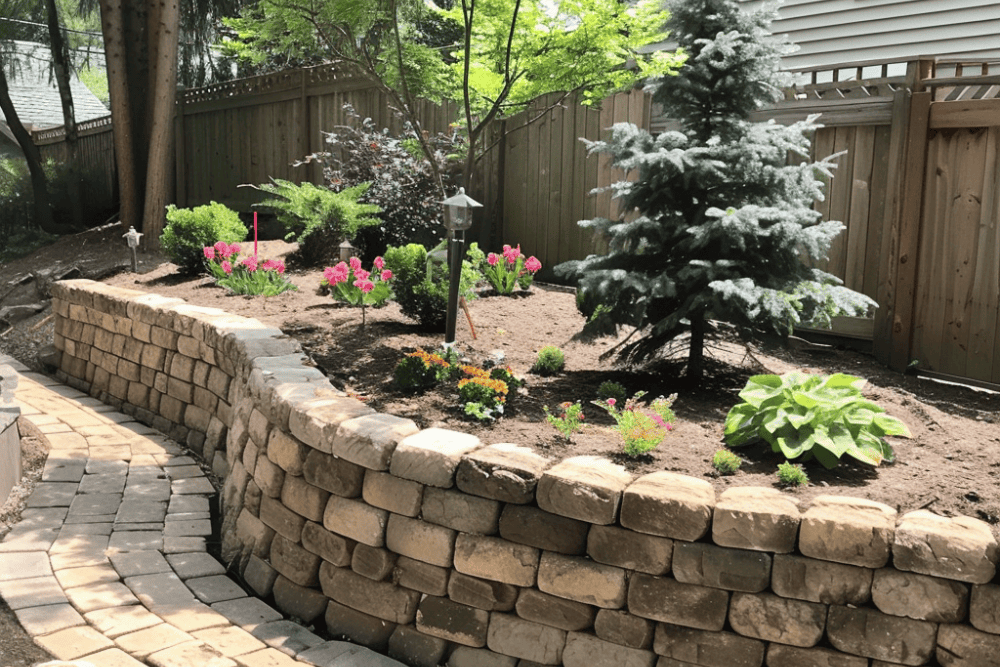
A planting area for a flower bed and trees on top of a small retaining wall
Compliance and Safety Measures
When building retaining walls for gardens, you must follow local regulations and ensure the wall’s structural integrity. This helps avoid legal issues and ensures safety.
Understanding Local Regulations
Before starting your project, check with local officials to see if you need a building permit. Any wall higher than 3 or 4 feet usually requires one.
Requirements will vary across the front range. The City and County of Denver has a permitting page that addresses retaining walls.
Permits often come with specific guidelines on materials and construction methods. Ignoring these rules may lead to fines or having to redo the work. Always consult professionals familiar with local codes. They can tell you what permits and other documents you might need. This step saves time and prevents legal problems.
Ensuring Structural Integrity
A strong foundation is key. Excavate a trench several inches wider and deeper than the wall. Make sure it is level and compacted. Then lay a layer of gravel or crushed stone.
Use sturdy materials for the wall. Block, stone, or wood can work well. Follow expert advice on the best material for your garden’s needs. Include proper drainage to prevent water from building up behind the wall. Standing water can weaken the structure. Consider using backfill to reinforce the wall after each row of blocks. This adds extra strength and ensures longevity.

